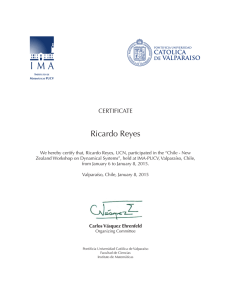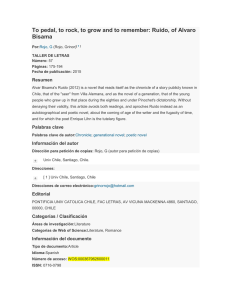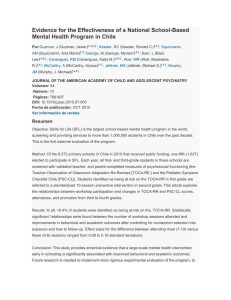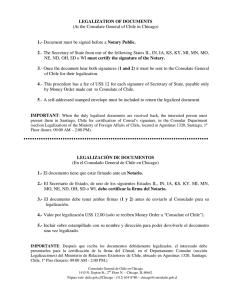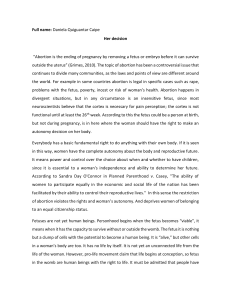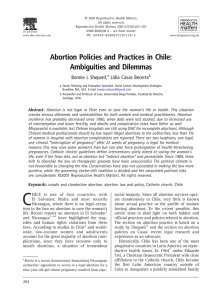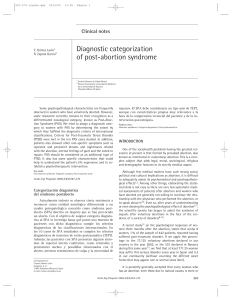Induced Abortion in Chile
Anuncio
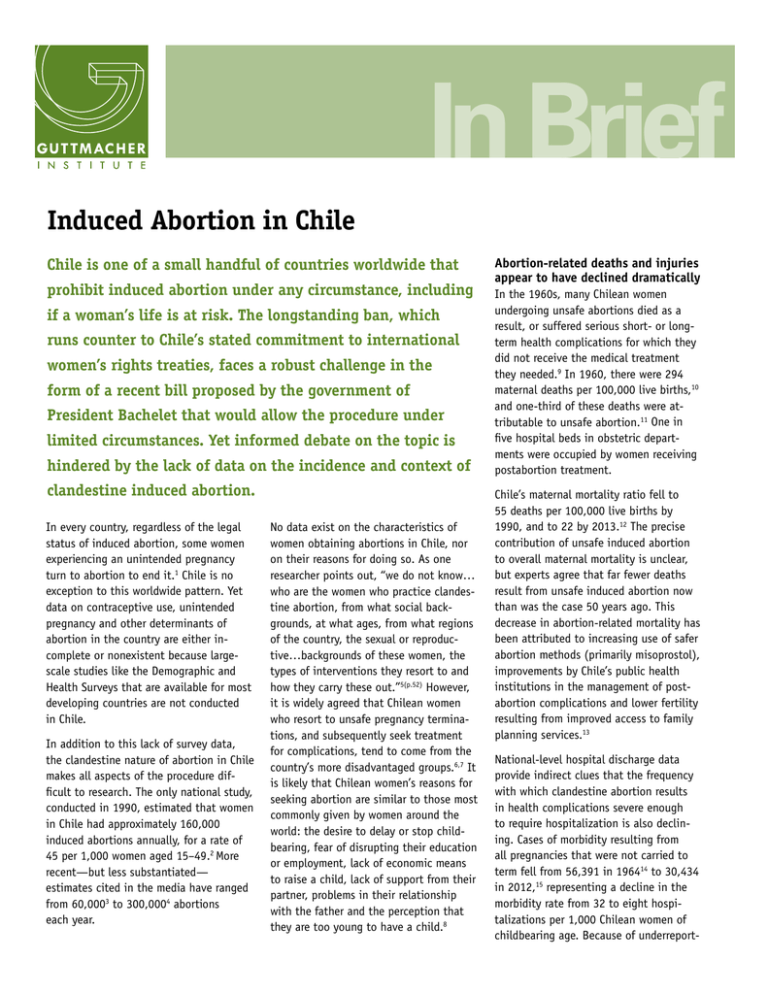
In Brief Induced Abortion in Chile Chile is one of a small handful of countries worldwide that prohibit induced abortion under any circumstance, including if a woman’s life is at risk. The longstanding ban, which runs counter to Chile’s stated commitment to international women’s rights treaties, faces a robust challenge in the form of a recent bill proposed by the government of President Bachelet that would allow the procedure under limited circumstances. Yet informed debate on the topic is hindered by the lack of data on the incidence and context of clandestine induced abortion. In every country, regardless of the legal status of induced abortion, some women experiencing an unintended pregnancy turn to abortion to end it.1 Chile is no exception to this worldwide pattern. Yet data on contraceptive use, unintended pregnancy and other determinants of abortion in the country are either incomplete or nonexistent because largescale studies like the Demographic and Health Surveys that are available for most developing countries are not conducted in Chile. In addition to this lack of survey data, the clandestine nature of abortion in Chile makes all aspects of the procedure difficult to research. The only national study, conducted in 1990, estimated that women in Chile had approximately 160,000 induced abortions annually, for a rate of 45 per 1,000 women aged 15–49.2 More recent—but less substantiated— estimates cited in the media have ranged from 60,0003 to 300,0004 abortions each year. No data exist on the characteristics of women obtaining abortions in Chile, nor on their reasons for doing so. As one researcher points out, “we do not know… who are the women who practice clandestine abortion, from what social backgrounds, at what ages, from what regions of the country, the sexual or reproductive…backgrounds of these women, the types of interventions they resort to and how they carry these out.”5(p.52) However, it is widely agreed that Chilean women who resort to unsafe pregnancy terminations, and subsequently seek treatment for complications, tend to come from the country’s more disadvantaged groups.6,7 It is likely that Chilean women’s reasons for seeking abortion are similar to those most commonly given by women around the world: the desire to delay or stop childbearing, fear of disrupting their education or employment, lack of economic means to raise a child, lack of support from their partner, problems in their relationship with the father and the perception that they are too young to have a child.8 Abortion-related deaths and injuries appear to have declined dramatically In the 1960s, many Chilean women undergoing unsafe abortions died as a result, or suffered serious short- or longterm health complications for which they did not receive the medical treatment they needed.9 In 1960, there were 294 maternal deaths per 100,000 live births,10 and one-third of these deaths were attributable to unsafe abortion.11 One in five hospital beds in obstetric departments were occupied by women receiving postabortion treatment. Chile’s maternal mortality ratio fell to 55 deaths per 100,000 live births by 1990, and to 22 by 2013.12 The precise contribution of unsafe induced abortion to overall maternal mortality is unclear, but experts agree that far fewer deaths result from unsafe induced abortion now than was the case 50 years ago. This decrease in abortion-related mortality has been attributed to increasing use of safer abortion methods (primarily misoprostol), improvements by Chile’s public health institutions in the management of postabortion complications and lower fertility resulting from improved access to family planning services.13 National-level hospital discharge data provide indirect clues that the frequency with which clandestine abortion results in health complications severe enough to require hospitalization is also declining. Cases of morbidity resulting from all pregnancies that were not carried to term fell from 56,391 in 196414 to 30,434 in 2012,15 representing a decline in the morbidity rate from 32 to eight hospitalizations per 1,000 Chilean women of childbearing age. Because of underreport- ing and likely misdiagnosis, it is difficult to distinguish what proportion of these hospitalizations involve women with complications from unsafe abortion attempts as compared with those requiring care for complications related to other reasons pregnancies are not carried to term (such as ectopic or molar pregnancy, or spontaneous pregnancy loss). More research on this topic is needed. Misoprostol is increasingly available in Chile Small-scale studies and anecdotal evidence suggest that wealthier Chilean women have access to safe abortions from skilled providers, whose most commonly used techniques are thought to be dilation and curettage, manual vacuum aspiration and, increasingly, medication abortion using misoprostol.16,17 Poorer Chilean women usually cannot afford to pay the fees charged by private obstetricians and gynecologists for safe procedures. However, increased access to misoprostol outside of formal health care settings demonstrates that lack of wealth may no longer be the insurmountable barrier to a relatively safe abortion that it once was. A small study from 2013 of women charged with breaking Chile’s abortion law found pregnancy terminations using misoprostol cost US$75–$215,18 whereas procedures of varying levels of safety carried out by physicians are said to cost as much as US$2,000.19 after the first trimester or at the wrong dosage, this method can result in incomplete abortion, heavy bleeding and other complications. Many unscrupulous online vendors appear to be selling fake pills or supplying women with incorrect dosages and charging high prices for them.19 The medication often comes without information on its correct use, even when the correct dosage is supplied. Aside from the increase in misoprostol use among those who can obtain and afford it, abortion methods in Chile have changed very little since the 1990s. Those who are unable to obtain safe services through trained providers still resort to traditional methods, which are often unsafe, ineffective or both. These range from drinking boiled beer or herbal teas to inserting knitting needles, scissors or rubber catheters into the cervix.21,22 Although illegal when sold or used to induce abortion, misoprostol can easily be acquired in Chile through the Internet and is also available through some providers of clandestine abortion. When used in the first nine weeks of pregnancy and at the correct dosage, the drug successfully ends a pregnancy in 75–90% of cases.20 When used Poor women bear the brunt of abortion-related prosecution Abortion law in Chile Each year, Chilean women and men are reported to local authorities for having or assisting in an induced abortion.16,18 Poor women are thought to be the most likely to use unsafe abortion methods and the most likely to seek postabortion treatment in public health facilities, which are the source of almost all abortion-related denunciations to the criminal justice system. According to national police reports, between 2003 and 2012, a total of 3,570 women and 975 men in Chile were sentenced for these infractions of the existing penal code.16 The lawyer who analyzed these statistics concludes that cases of “criminal prosecution Between 1931 and 1989, Chile’s Sanitary Code permitted induced abortions to save a woman’s life.1 In 1989, near the end of Augusto Pinochet’s regime, a total ban on abortion was put in place. Legislators have since made many attempts to loosen that ban but, with the support of the highly influential Catholic Church, members of Congress opposed to changing the law have successfully blocked all such legislative initiatives.2,3 The most recent proposed bill, introduced in January 2015, would amend existing health and penal codes to allow the procedure under three circumstances: when the woman is at such risk that the abortion would prevent a danger to her life; when the embryo or fetus has a fatal genetic or congenital malformation; and when the pregnancy is the result of rape and has reached no more than 12 weeks’ gestation (for girls younger than 14, the limit is 14 weeks).4 The draft bill would prioritize patient confidentiality above the requirement that doctors denounce women they treat, while also allowing for conscientious objection on the part of individual doctors or surgeons unwilling to perform legal abortions on the grounds covered by the proposed bill. Physicians granted this exemption would be required to ensure that a substitute doctor be assigned. In September 2015, the bill passed the Health Commission of the lower house of Congress, and as of this writing, it is under review by the Constitutional, Legislative and Justice Commission; it will need to be approved by the lower and upper houses of Congress to become law.5 References on page 4. Induced Abortion in Chile 2 are very selective, involving most of all…the poorest women.”16(p.72) The number of women who are incarcerated for obtaining an abortion has dropped dramatically in recent years, from 88 in 2003 to five in 2012, and most are now sentenced to probation. The length of sentences for women convicted of obtaining or assisting in an abortion between 2003 and 2012 ranged from 1.5 to three years, as mandated in the penal code.23 Doctors and professional midwives found to have performed abortions received sentences of 3–5 years; unskilled or untrained providers (including traditional birth attendants) received sentences of no more than three years. Data about contraceptive use in Chile are lacking In the absence of survey data on pregnancy intentions and contraceptive use, it is impossible to estimate the level of unmet need for modern contraception. The only available estimate of contraceptive use for Chile is for the combined population of men and women aged 15 and older—a nonstandard measure that does not permit assessment of the needs among women of reproductive age.24 Unless the vast majority of women who want to avoid pregnancy are using effective contraceptive methods consistently and correctly, both unintended pregnancy and abortion are likely occurring at substantial levels.25,26 Data on adolescents and young adults hint at the particular risks and challenges faced by young people in Chile. As of 2009, the average age at first intercourse was 16 for men and Guttmacher Institute 17 for women, and more than nine in 10 young people aged 15–29 had never married, indicating than many young people become sexually active well before they are likely to want to have a child.27 Yet schoolbased sex education may not be meeting adolescents’ needs for comprehensive, evidence-based information: A 2006 assessment of Chile’s official sex education program concluded that the program did not include instruction on the negative consequences of unwanted pregnancy in adolescence or provide advice that could help students avoid early out-of-wedlock childbearing.28 As of 2009, four in 10 sexually experienced women aged 15–19 had had an unintended pregnancy, and 7% of young people aged 15–29 who had experienced an unintended pregnancy reported that it had ended in an induced abortion.27 This low proportion likely reflects underreporting, however, due to the illegality of the procedure. Worldwide, induced abortion— whether legal or clandestine— is most often sought in response to unintended pregnancy. Most Chilean couples want to have small families, and to achieve their desired family size and avoid the need for abortion, they need to use effective contraceptive methods correctly and consistently for the majority of their reproductive lives. Research on unintended pregnancy and unmet need for contraception is needed both to contextualize women’s recourse to abortion and to help assess and improve women’s ability to plan the timing and number of their pregnancies. Summary 3. Díaz S, Aspectos médicos del aborto, Santiago: Instituto Chileno de Medicina Reproductiva, 2012, slide 30. The deficit of knowledge on the prevalence and consequences of induced abortion in Chile prevents a fully informed debate on the impact of clandestine abortion on Chilean women and families. Research is needed to fill this gap and provide policymakers and health care providers with the information they need to devise sound policies and interventions that best promote the nation’s public health. New data and policies are particularly important to verify and address the inequities suggested by the existing data: Poor women appear to be at an elevated risk for obtaining unsafe procedures and for being prosecuted as a result. Guttmacher Institute 7. Basadre P and Toro I, Cómo opera la justicia en los casos de aborto: la historia de tres condenadas por el “delito de mujeres pobres,” The Clinic, 2014, http:// www.theclinic.cl/2014/06/12/ como-opera-la-justicia-en-loscasos-de-aborto-la-historia-de-trescondenadas-por-el-delito-de-lasmujeres-pobres/#commentsSection. 8. Bankole A, Singh S and Haas T, Reasons why women have induced abortions: evidence from 27 countries, International Family Planning Perspectives, 1998, 24(3):117–127 & 152. 9. Faúndes A and Barzelatto J, The Human Drama of Abortion: A Global Search for Consensus, Nashville, TN, USA: Vanderbilt University Press, 2006. 10. Molina Cartes R, Perspectiva medico-epidemiológica del aborto en Chile, in: AFLD, Voces Sobre el Aborto, Ciudadanía de las Mujeres, Cuerpo y Autonomía, Santiago: AFLD, Escuela de Salud Pública, Universidad de Chile, 2014, Table 1. REFERENCES 1. Singh S et al., Abortion Worldwide: A Decade of Uneven Progress, New York: Guttmacher Institute, 2009. 11. Ministerio Secretaría General de la Presidencia, República de Chile, Mensaje 1230–362: Mensaje de S. E. la Presidenta de la República con el que inicia un Proyecto de Ley que regula la despenalización de la interrupción voluntaria del embarazo en tres causales, 2015, http://www. minsegpres.gob.cl/wp-content/ upLoads/2015/01/1230-362despenalia-interrupcion-emabrazo-3causales-con-ingreso-camara.pdf. 2. Singh S and Wulf D, Estimated levels of induced abortion in six Latin American Countries, International Family Planning Perspectives, 1994, 20(1):4–13. 4. Jarroud M, Chile afronta su deuda con el derecho al aborto de las mujeres, Inter Press Service, 2015, http://www.ipsnoticias. net/2014/09/chile-afronta-su-deudacon-el-derecho-al-aborto-de-lasmujeres/. 12. World Health Organization (WHO), Trends in Maternal Mortality: 1990 to 2013, 2014, Appendix 2, http://apps.who.int/iris/bitstr ea m/10665/112682/2/97892415072 26_eng.pdf?ua=1. 13. Donoso Siña E, Reducción de la mortalidad materna en Chile de 1990 a 2000, Revista Panamericana de Salud Pública, 2004, 15(5):326– 330, doi: 10.1590/S102049892004000500007. 5. Palma Manríquez I and Moreno Standen C, Las paradojas y desafíos para la investigación social del aborto inducido en Chile, in: Articulación Feminista por la Libertad de Decidir (AFLD), Voces Sobre el Aborto, Ciudadanía de las Mujeres, Cuerpo y Autonomía, Santiago: AFLD, Escuela de Salud Pública, Universidad de Chile, 2014, pp. 51–59. 14. Molina Cartes R, Impacto del aborto, in: Dides C, Benavente MC and Sáez I, eds., Dinámicas Políticas sobre Aborto en Latinoamérica: Estudio de Casos, Santiago: FlacsoChile, 2010, pp. 17–43. 6. Casas Becerra L, Women prosecuted and imprisoned for abortion in Chile, Reproductive Health Matters, 1997, 5(9):29–36. 3 15. Departamento de Estadísticas e Información de Salud I (DEIS), Ministerio de Salud, Gobierno de Chile, Egresos Hospitalarios Según Edad y Causa—Servicios, 2012, no date, http://intradeis.minsal.cl/ egresoshospitalarios/menu_publica_ nueva/menu_publica_nueva.htm. 16. Casas Becerra L et al., La penalización del aborto como una violación a los derechos humanos de las mujeres, Capítulo 2, in: Universidad Diego Portales (UDP), Informe Anual sobre Derechos Humanos en Chile 2013, Santiago, Chile: Centro de Derechos Humanos, 2014, pp. 69–120, http://www. clacaidigital.info:8080/xmlui/ handle/123456789/527. 17. Jones E, Chile’s black-market abortions, Pulsamerica, 2011, http:// www.pulsamerica.co.uk/2011/04/14/ chile’s-black-market-abortions/. 18. Casas Becerra L and Vivaldi L, Abortion in Chile: the practice under a restrictive regime, Reproductive Health Matters, 2014, 22(44):70–81. 19. Crellin O, Therapeutic abortion shot down again in Chilean Congress, International Consortium for Medical Abortion, no date, http://www.medicalabortionconsortium.org/news/ therapeutic-abortion-shot-downagain-in-chilean-congress-1598. html. 20. WHO, WHO Reproductive Health Library, Medical methods for first trimester abortion, 2004, http:// apps.who.int/rhl/ fertility/abortion/ dgguide/en/. 21. Weisner M et al., Algunos resultados de la encuesta sobre opiniones acerca del aborto clandestino realizada por el AGI en Brasil, Chile, Colombia, Mexico, Peru y Republica Dominicana, paper presented at Encuentro de Investigadores sobre Aborto Inducido en América Latina y el Caribe: Atención Hospitalaria y Costos del Aborto, Santafé de Bogotá, Colombia, Nov. 15–18, 1994. 22. Lesbianas y Feministas por el Derecho a la Información, Línea Aborto Chile: El Manual ¿Cómo las Mujeres Pueden Hacerse un Aborto con Pastillas? 2013, http:// infoabortochile.org/wp-content/ uploads/2013/05/manual.pdf. Induced Abortion in Chile 23. Casas Becerra L, Facultad de Derecho, Centro de Derechos Humanos, Universidad Diego Portales, Santiago, Chile, personal communication, Apr. 28, 2015. 24. Ministerio de Salud, Gobierno de Chile, II Encuesta de Calidad de Vida y Salud, Chile, 2006, Informe de Resultados, Total Nacional, 2006, http://www.crececontigo.gob.cl/ wp-content/uploads/2013/06/ ENCAVI-2006.pdf. 25. DEIS, Tasa global de fecundidad, Chile, 1992–2011, no date, http:// www.deis.cl/?page_id=3307. 26. Bongaarts J and Westoff CF, The potential role of contraception in reducing abortion, Studies in Family Planning, 2000, 31(1):193–203. 27. Instituto Nacional de la Juventud, Gobierno de Chile, 6ta Encuesta Nacional de Juventud 2009, 2010, pp. 256–281, http://www. injuv.gob.cl/portal/wp-content/files_ mf/sextaencuestanacionaldejuventud. pdf. 28. Olavarría J, La Política de Educación Sexual del Ministerio de Educación de Chile. Consideraciones para una Evaluación, 2006, Santiago, Chile: Seminario Internacional Equidad de Género en las Reformas Educativas de América Latina, 2005, http://www.pasa.cl/wp-content/ uploads/2011/08/La_Politica_ de_Educacion_del_Ministerio_de_ Educacion_de_Chile_ Olavarr.doc. BOX REFERENCES CREDITS 1. Casas Becerra L and Vivaldi L, Abortion in Chile: the practice under a restrictive regime, Reproductive Health Matters, 2014, 22(44):70–81. This In Brief was written by Elena Prada, independent consultant, and Haley Ball, Guttmacher Institute. It was edited by Lisa Melhado, Guttmacher Institute. The authors are grateful for the suggestions provided by Ann Biddlecom and Julia Ferré, United Nations Population Division; Lidia Casas, University of Diego Portales School of Law, Chile; Claudia Dides, Miles, Chile; Ramiro Molina, School of Public Health, University of Chile; and Cristina Villarreal, Orientame, Colombia. They also thank the following Guttmacher colleagues for their input: Sneha Barot, Isaac Maddow-Zimet, Lisa Remez, Susheela Singh and Gustavo Suárez. 2. Casas Becerra L et al., La penalización del aborto como una violación a los derechos humanos de las mujeres, Capítulo 2, in: Universidad Diego Portales, Informe Anual sobre Derechos Humanos en Chile 2013, Santiago, Chile: Centro de Derechos Humanos, 2014, pp. 69–120, http://www. clacaidigital.info:8080/xmlui/ handle/123456789/527. 3. Maturana-Kesten C, Aborto: derechos humanos de las mujeres frente al parlamento chileno, in: AFLD, Voces Sobre el Aborto, Ciudadanía de las Mujeres, Cuerpo y Autonomía, Santiago: Articulación Feminista por la Libertad de Decidir, Escuela de Salud Pública, Universidad de Chile, 2014, pp. 81–90. Suggested citation: Prada E and Ball H, Induced abortion in Chile, In Brief, New York: Guttmacher Institute, 2016. 4. Cámara de Diputados de Chile, Informe de la Comisión de Salud recaído en el proyecto que regula la despenalización de la interrupción voluntaria del embarazo en tres causales, 2015, no. 9.895-11, Artículo 119. 5. Center for Reproductive Rights, Chile’s health commission approves abortion bill, press release,2015, http://www.reproductiverights. org/press-room/chiles-healthcommission-approves-abortion-bill. Advancing sexual and reproductive health worldwide through research, policy analysis and public education 125 Maiden Lane New York, NY 10038 USA Tel: 212.248.1111 info@guttmacher.org www.guttmacher.org January 2016




